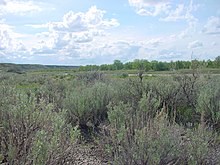
Artemisia is a large, diverse genus of plants belonging to the daisy family Asteraceae, with between 200 and 400 species. Common names for various species in the genus include mugwort, wormwood, and sagebrush.
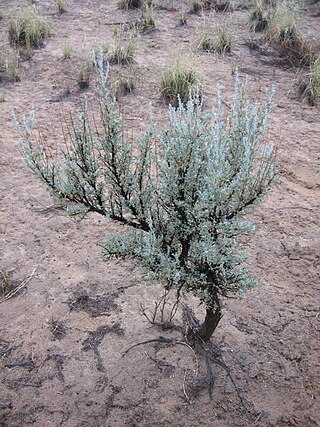
Artemisia tridentata, commonly called big sagebrush, Great Basin sagebrush or simply sagebrush, is an aromatic shrub from the family Asteraceae.

Arctostaphylos glandulosa, with the common name Eastwood's manzanita, is a species of manzanita.

Artemisia pycnocephala is a North American species of sagebrush in the sunflower family, known by the common names beach wormwood, sandhill sage, and coastal sagewort.
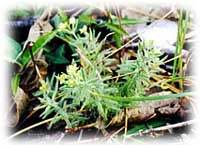
Galium californicum is a species of flowering plant in the coffee family known by the common name California bedstraw.
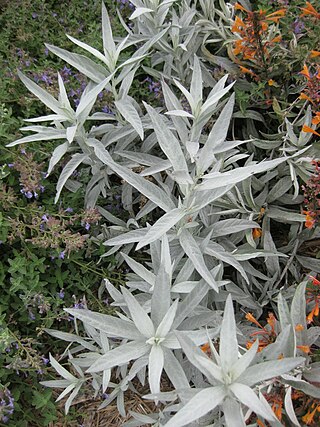
Artemisia ludoviciana is a North American species of flowering plant in the daisy family Asteraceae, known by several common names, including silver wormwood, western mugwort, Louisiana wormwood, white sagebrush, lobed cud-weed, prairie sage, and gray sagewort.

Artemisia biennis is a species of sagebrush known by the common name biennial wormwood. It is a common and widely distributed weed, so well established in many places that its region of origin is difficult to ascertain. This species is most likely native to northwestern North America and naturalized in Western Europe, and eastern and southern North America.

Artemisia michauxiana is a North American species of wormwood in the sunflower family. It is known by the common names Michaux's wormwood and lemon sagewort. It is native to the western United States and Canada. It grows in mountain talus habitats in subalpine to alpine climates.

Artemisia palmeri is a rare species of sagebrush known by the common names San Diego sagewort and Palmer sagewort.

Artemisia rothrockii is a North American species of sagebrush known by the common names timberline sagebrush and Rothrock's sagebrush.

Artemisia suksdorfii is a North American species of sagebrush in the sunflower family. It is known by the common names coastal mugwort, coastal wormwood, and Suksdorf sagewort. It is native to coastal regions from British Columbia, Washington, Oregon, and northern California as far south as Sonoma County, with isolated populations on Santa Catalina Island in Los Angeles County.

Chrysothamnus viscidiflorus is an American species of shrub in the family Asteraceae known by the common names yellow rabbitbrush and green rabbitbrush.

Crepis modocensis is a species of flowering plant in the family Asteraceae known by the common name Modoc hawksbeard.
Monardella australis is a species of flowering plant in the mint family, known by the common name southern monardella.

Monardella hypoleuca is a species of flowering plant in the mint family, known by the common names thickleaf monardella and white leaf monardella.
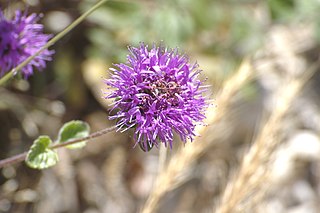
Monardella undulata is an uncommon species of flowering plant in the mint family known by the common name curlyleaf monardella. It is an annual herb and is endemic to the coast of California.

Oenothera primiveris is a species of flowering plant in the evening primrose family known by the common names yellow desert evening primrose, bottle evening-primrose, and desert evening-primrose.

Orobanche californica, known by the common name California broomrape, is a species of broomrape. It is a parasitic plant growing attached to the roots of other plants, usually members of the Asteraceae.

Stellaria longipes is a species of flowering plant in the family Caryophyllaceae known by the common names longstalk starwort and Goldie's starwort. It has a circumpolar distribution, occurring throughout the northernmost latitudes of the Northern Hemisphere. It is a perennial herb that grows in a wide variety of habitat types, including tundra and taiga and many areas farther south with subalpine and alpine climates. It is extremely variable in morphology, its form depending on both genetic makeup and environmental conditions. It has a widely varying number of chromosomes. In general, it is a rhizomatous perennial herb forming mats or clumps, or growing erect. The stems may be short and simple or with sprawling and highly branched. The linear to lance-shaped leaves are usually 1 to 4 centimeters long and are oppositely arranged in pairs. The inflorescence bears one or more flowers, each on a short pedicel. The flower has five pointed green sepals each a few millimeters long. There are five white petals each divided into two lobes, sometimes shallowly, but often so deeply there appear to be two petals. The plant is gynodioecious, with some flowers having functional male and female reproductive parts and others being only female.
Trifolium bolanderi is a species of clover known by the common names Bolander's clover and parasol clover.
